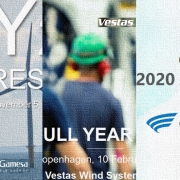ASP: the worst (and most popular) turbine price indicator
ASP or Average Selling Price is the main indicator used by wind turbine manufacturers in their earnings presentations to inform analysts about the evolution of the average turbine price. This indicator is one of the most used data by these financial analysts to guess the causes of high or low profitability. But it has a small problem: it has nothing to do with profitability and often leads to wrong conclusions.
What is the ASP?
As its name suggests, the Average Selling Price is the result of dividing the turbine sales turnover by the number of MWs sold. In other words, it is a ratio of €/MW or $/MW.

As seen above, it is used to show price trends over several periods. With this information, analysts deduce that, if the ASP has decreased, prices have decreased and therefore profitability has been affected. If, on the other hand, ASP is increasing, prices are higher and profitability should improve… all very simple.
Why is ASP useless?
A turbine is made up of a tower, nacelle and rotor. As an easy rule of thumb, each of these elements contributes one third to the cost (and price) of the machine. But the ASP only takes into account the nominal power that is directly related to the nacelle. It deals with a 3 MW turbine, 90m rotor and 80m tower in the same way as a 3 MW turbine, 140m rotor and 120m tower, when it is easy to assume that both the cost and the price of both turbines are very different.
Let’s look at an example. If we take several hypothetical projects with different turbines, we could calculate the theoretical cost by applying estimated ratios for nacelle, rotor and tower. If for each project we apply an invented price, we can obtain a margin and the famous ASP for each project (dividing price by nominal power).

As we can see, selling prices can be adjusted to reach the absurdity of having similar ASPs when the theoretical profitability is totally different. In fact, the correlation between both values is very low. It could be the case that one quarter we have project P0001 with high profitability and ASP 0.54 and in the following quarter, we have P0007 with negative profitability but with an ASP of 0.55, so the analysis would be that prices are rising when the reality is that the turbines are totally different, their costs are very different and the ASP is leading to the wrong conclusion.
If it is so bad, why is it still being used?
With the limitations of the ASP being so obvious, it is hard to understand why it is still used as a benchmark. It is probably for historical reasons because in the early days of the industry, manufacturers’ product portfolios were much more limited, with fewer products and, above all, far fewer rotor and tower options. As an example, The old 2 MW platform from Vestas and Gamesa had rotors between 80 and 90m and tower heights between 67 and 78m. With so little variation, the ASP was a valid reference.
But today, with products that can fit rotors between 120m and 150m or tower catalogues between 100m and 160m, the error of using ASP with such different products is very significant. In fact, as the trend in the industry is to grow rotors and towers to increase the capacity factor in low winds, anything less than a clearly growing ASP will mean a price reduction as the customer will be buying more expensive machines (bigger rotor and tower) at the same price. And as cost reduction is not infinite (especially in these times of skyrocketing raw materials and transport), profitability will be seriously affected.
Are there alternatives to ASP?
Basically, There might be 2 types of alternatives to the current ASP
1) Blended index: index combining nacelle, rotor and tower instead of using only the rated power.
To illustrate this, let’s look at an example of a fictitious one that we have called ASP+: it involves taking a reference turbine and constructing an index combining the variations of nacelle, rotor and tower with respect to the reference. In our case, we take as a reference the 3MW turbine, 90m rotor and 80m tower. The combined index will be formed by adding the variation of the 3 elements. The ASP+ would be constructed by dividing the selling price by the combined index.

As can be seen in the table above, the correlation between ASP+ and profitability is now very high as the combined index we have used and the way of estimating the cost is very similar. But, although this example is quite rough, it certainly reflects the evolution of turbine prices much better than the actual ASP (Note: the costs and prices in the example are fictitious and for illustrative purposes only).
The big problem with this type of solution by switching to a blended index is that it increases the complexity and would also require the use of a new index.
2) More information: If, in addition to the ASP, manufacturers would provide the average size of rotors and towers sold, there would be enough information to draw conclusions. If they also provided the average power (this can already be calculated in many cases with the data on units and MW), home-made blended indexes could be constructed so that each analyst could draw his or her own conclusions.
In short, the ASP as a ratio to indicate the health of the sector has become obsolete, but it seems that everyone is happy with it, so do not expect any change in the short term. We do see some manufacturers starting to provide more data on their order book in order to better characterise it and thus deduce the future profitability of the company.










